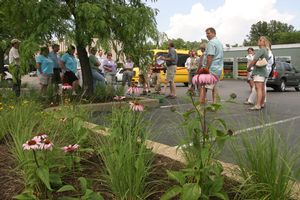
A Grow Native! professional tour visits the Alpine Shop located in downtown Kirkwood. The Alpine Shop landscape features native plants supplied by Bohn's Farm and Greenhouses. (Photo credit: Robert Weaver, The Gateway Gardener Magazine)
Native Plants
Specializing in Native Plants of the Lower Midwest
Bohn's Farm and Greenhouses strives to produce, within a managed production nursery setting, the most extensive selection of Midwest native perennials found in the lower Midwest. Our extensive selection of ecotype species and landscape "nativars" are grown in a variety of container sizes to suit the needs of both the landscape professional and the retail merchant. Special production emphasis in recent years includes native species required for constructing rain gardens, bioswales, and stormwater detention and retension infrastructures according to the "St.Louis County Phase II Stormwater Management Plan" and "Sustainable Practices" adopted by the St. Louis Metropolitan Sewer District (MSD).
Additional Information
Bohn's Farm wishes to extend a sincere thank you to the Shaw Nature Reserve team for their educational assistance to expand our knowledge of native plants via their educational programs and ongoing development and management of The Whitmire Wildflower Garden.
An active member since the inception of the program, Bohn's Farm also values association with the Grow Native! a native plant awareness program jointly managed by the Missori Department of Conservation and Missouri Department of Agriculture.
Bohn's Farm RESPONSIBLE CODE OF CONDUCT: All native plants we offer are propagated from seeds responsibly collected or vegetative cuttings from controlled nursery-produced stock plants. We DO NOT purchase propagated materials from plant material collected in the wild.
Achillea millefoliumYarrow
Achillea millefolium, commonly called common yarrow, is a rhizomatous, spreading, upright to mat-forming perennial that is considered by many to be an aggressive weed. Common yarrow from Europe and Asia was originally introduced to America in colonial times, and has since naturalized throughout the U. S. primarily along roadsides, fields, waste areas and lawns. These species plants are noted for producing deeply-dissected, fern-like, aromatic, medium green foliage and tiny, long-lasting, white flowers that appear in dense, flattened, compound corymbs (to 2-4"across) throughout the summer on stems typically rising 2-3’ tall. Foliage has a strong, somewhat spicy aroma that persists when used in dried arrangements.
[
More Info
]
|
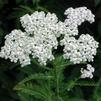
|
Adiantum pedatumFern, Northern Maidenhair
Dainty bright green fronds on shiny black stems create a light, airy texture. Spreads by shallow rhizomes to form a dense groundcover . Thrives in moist, loose, rich soil.
[
More Info
]
|
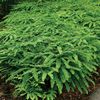
|
Amorpha fruticosaFalse Indigo Bush
Long racemes of purple flower bloom in May and June. Foliage has shrub-like habit and pinnately compound leaves. Grows along stream banks and moist woods.
[
More Info
]
|
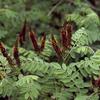
|
Amsonia illustrisBlue Star, Shining
Clusters of pale blue, star-like flowers grace a substantial mound of shiny, leathery leaves in May. Foliage often turns gold in fall. An easy-care native of the Ozarks.
[
More Info
]
|
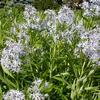
|
Amsonia tabernaemontanaBlue Star
Loose clusters of lilac blue star-shaped flowers bloom in May. Willow like leaves turn a stunning shade of yellow-orange in autumn. Drought tolerant. Easy to grow. Midwest native.
[
More Info
]
|
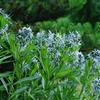
|
Amsonia tabernaemontana 'Storm Cloud'Blue Star
Amsonia tabernaemontana, commonly called bluestar, is a Missouri native herbaceous perennial which occurs most frequently in rich, open woods and thickets in the southwestern part of the State. An erect, clump-forming plant which features terminal, pyramidal clusters of 3/4", soft light blue, star-like flowers in late spring atop erect, leafy stems growing 2-3' tall. Narrow, willow-shaped, dull green foliage may turn an attractive yellow in fall.
‘Storm Cloud’ features near black stems in spring clad with silver-veined dark green leaves. Leaves lighten to olive green by summer. Light periwinkle-blue, star-shaped flowers bloom abundantly from late spring to early summer, often with some rebloom thereafter. Plants typically grow to 24-30" tall spreading to as much as 42" wide.
[
More Info
]
|
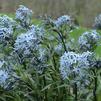
|
Andropogon gerardiiGrass, Big Bluestem
King of native grasses! Blue-green foliage that can reach 8' tall forms distinctive seed heads in late summer. Nice red color in fall. Ideal as a background plant, specimen or in naturalized plantings.
[
More Info
]
|
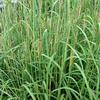
|
Anemone canadensisAnemone, Meadow
A strong growing plant that needs room to move. Clear white single flowers top out at 18" from mid spring to early summer. A robust and competitive native plant that brightens up woodland edges and shady corners of the garden.
[
More Info
]
|

|
Aquilegia canadensisColumbine
Lots of red and yellow nodding flowers for many weeks from late April until mid June. A great source of early nectar for butterflies and hummingbirds. Found naturally on rocky ledges and wooded rocky slopes.
[
More Info
]
|
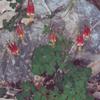
|
Aruncus dioicusGoat'S Beard
Large wands of frothy, creamy white flowers in May and June. Foliage is similar to astilbe but growth habit is shrub-like. A good native for woodland gardens.
[
More Info
]
|
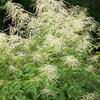
|
Asclepias incarnataMilkweed, Swamp
Clusters of long-lasting vanilla-scented rose-pink flowers are butterfly magnets in July and August. A host plant for Monarch larvae, and a nectar plant for many butterfly species. Grows best in moist soils, but tolerates drier conditions.
[
More Info
]
|
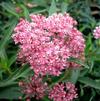
|
Asclepias incarnata 'Cinderella'Milkweed, Swamp
Large 3-4" clusters of fragrant vanilla-scented rose-pink flowers in July and August over lush green foliage attract butterflies and beneficial insects from midsummer to early fall. Grows best in moist soils but tolerant of drier conditions.
[
More Info
]
|
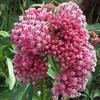
|
Asclepias purpurascensMilkweed, Purple
Asclepias purpurascens, Purple Milkweed looks similar to Common Milkweed (Asclepias syriaca), but the flower color is a rich red purple color compared to the soft gray-pink of Common Milkweed. There are usually one to three blooms that form near the ends of the stems in late spring, early summer.
The flower is held above the leaves on stems a bit longer then Common Milkweed’s and the umbel itself is stiff, and holds a nicely rounded form while that of Common will flop a bit. Blooms can last for about a month and if seed is not set it will occasionally re-bloom. The average height is around 3 feet but it will sometimes go to 4 feet. The flowers will attract a variety of nectar seeking insects from the very small to large Bumble Bees and of course Monarch Butterflies. The leaves are big, around 6-8 inches and they taper to a point at both ends. The mid-vein in the leaves is tinted with the same color as the flower.
Grow Asclepias purpurascens in a site that is well drained but has ample moisture. It seems to prefer a bit of shade but will do well in full sun if it gets deep, regular watering. This Milkweed will not spread aggressively like the Common does. The seed pods are smooth and a little more slender than those of Common Milkweed which has plump pods with a prickly surface.
[
More Info
]
|
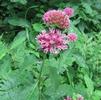
|
Asclepias sullivantiiMilkweed, Sullivant'S
Similar to Common Milkweed but is less aggressive, has slightly smaller flowers, and an overall smooth appearance on the stem, leaves and seed pods. Visited by hummingbirds and a wide variety of bees and butterflies (including, of course, Monarchs), Prairie Milkweed is one of the plants favored by the larvae of the Milkweed Leaf-Miner fly, which bore holes in the leaves.
Bears a very fragrant pink flower, Prairie Milkweed makes a nice addition to any sunny medium to medium-moist garden. After just a few years the taproot will extend very deep, protecting the plant in times of drought, but also making it difficult to move so choose your spot wisely.
[
More Info
]
|
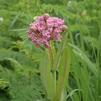
|
Asclepias syriacaMilkweed, Common
This native classic is best known as a food of larval monarch butterflies (along with its siblings A. incarnata and A. tuberosa). Robust and stoloniferous with deep pink clusters of fragrant flowers in June and July, followed by lovely pods of silky seeds in October.Monarch butterflies lay their eggs exclusively on Milkweed plants, making them the sole food source for their larvae. Once found in abundance in nearly every farm field, ditch, and disturbed site, Common Milkweed numbers have been in dramatic decline in recent years, due in part to suburban development and the increased efficiency of herbicides used in conjunction with herbicide-tolerant, genetically modified row crops. Common Milkweed is one of the easiest and fastest to establish of the Milkweeds. The large flower can vary in the color range from nearly white to deep pink-purple. The fragrance is very delicate and pleasing and numerous native pollinators will benefit during its long bloom time.
[
More Info
]
|
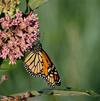
|
Asclepias tuberosaMilkweed, Butterfly
Abundance of bright orange flowers June through August. Host plant for the monarch butterfly and a superior nectar plant for many other butterfly species. Requires well-drained soil.
[
More Info
]
|
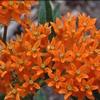
|
Asclepias verticillataMilkweed, Whorled
A widely adaptable and tough native is a deer-resistant food for larval butterflies. The fine-textured foliage provides a dark green backdrop for the clusters of white flowers that appear in June and July. Please note, Asclepias verticillata is highly toxic to livestock and horses - it should not be allowed to take root in pastures or hayfields. Found in dry fields, roadsides and shale barrens, you can see that it needs no coddling. Best located in a sunny dry spot, but will tolerate average to moist garden soil as well.
[
More Info
]
|
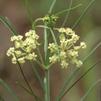
|
Asclepias viridisMilkweed, Spider
Green Milkweed shares with other Asclepias species its milky, irritating sap and strong attractiveness to Monarch butterflies and a host of other insects. Very tolerant of dry conditions, it is also called Green Antelopehorn. Green Milkweed features rose-white flowers surrounded by green that form in showy umbellated clusters, often one per plant. Its beauty and tendency to spread slightly make it a good garden choice. White crab spider lives on this plant.
[
More Info
]
|
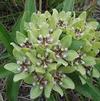
|
Aster (syn Symphyotrichum) novae-angliaeAster, New England
Blooms August and September. AKA Symphyotrichum novae-angliae.
[
More Info
]
|
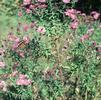
|
Aster (syn Symphyotrichum) novae-angliae 'Purple Dome'Aster, New England
Heavy blooming with deep purple flowers late July or early August and continuing through September and October. Densely compact mounded growth habit. While this plant may appear leggy in a container on the retail shelf, Purple Dome exhibits outstanding landscape performance and still offers the richest purple flower among all Asters. AKA Symphyotrichum novae-angliae.
[
More Info
]
|
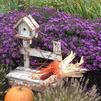
|
Aster (syn Symphyotrichum) oblongifoliusAster, Aromatic
A charming native with masses of blue-purple daisy like flowers blooming July through frost. Blue-green foliage forms tidy, compact, self-supporting mound and is aromatic when crushed. Neat, dome-shaped habit. AKA Symphyotrichum oblongifolium.
[
More Info
]
|
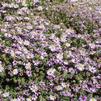
|
Aster (syn Symphyotrichum) oolentangiensisAster, Sky Blue
Dozens of blue flowers with yellow centers bloom in September and October. The foliage is blue-green and stems are dark. Butterflies love the nectar. AKA Symphyotrichum oolentangiense.
[
More Info
]
|
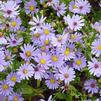
|
Athyrium filix-feminaFern, Lady
Bright green, lacy fronds arise from creeping rhizomes. Clumps are dense and upright. Vigorous and easy to grow.
[
More Info
]
|
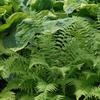
|
Athyrium filix-femina 'Lady in Red'Fern, Lady
Vibrant burgundy stems stand out against light green lacy fronds. Foliage is upright and arching. Naturalizes by creeping rhizomes.
[
More Info
]
|

|
Baptisia alba (syn. B. leucantha)Indigo, False
White flowers with black stems in May into early June. Slightly weeping habit. Native.
[
More Info
]
|
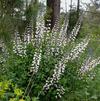
|
Baptisia australisIndigo, False
[
More Info
]
|
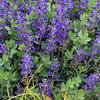
|
Bouteloua curtipendulaGrass, Sideoats Grama
Narrow leaves form compact clumps that turn an attractive gold in autumn with interesting reddish orange flowers and seed heads that are carried to one side of the stem. Attractive to birds and very drought tolerant.
[
More Info
]
|
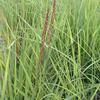
|
Bouteloua curtipendulaGrass, Sideoats Grama
[
More Info
]
|

|
Bouteloua gracilisGrass, Blue Grama
[
More Info
]
|
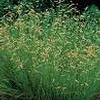
|
Calamagrostis canadensisGrass, Bluejoint
[
More Info
]
|
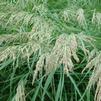
|
Calamintha nepeta ssp. nepetaCalamint
Plumes of delicate light blue flowers float over shiny mint-scented foliage from early summer to fall. Use in rock gardens, herb gardens and perennial borders. Grow in full sun with good drainage.
[
More Info
]
|
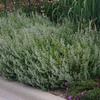
|
Callirhoe bushiiPoppy Mallow, Bush'S
Cup shaped magenta flowers bloom June through August. Rambling flower stems are more erect than those of the similar C. inbolucrata. Long tap root provides good drought tolerance buts makes transplanting of established plants more difficult.
[
More Info
]
|
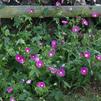
|
Callirhoe involucrataPoppy Mallow, Purple
Showy, cup-shaped magenta flowers bloom June through frost. Foliage forms trailing stems that forms excellent ground cover or hangs over walls. Drought tolerant.
[
More Info
]
|
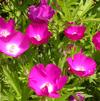
|
Carex albicansSedge, Whitetinge
[
More Info
]
|
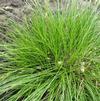
|
Carex amphibolaSedge, Creek
Compact, clump forming sedge with shiny, semi-evergreen foliage. Vigorous grower. Widely adaptable, preferring dry to moderate moisture conditions. A Midwest native.
[
More Info
]
|
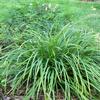
|
Carex annectensSedge, Yellow Fruited
Missouri Native sedge with attractive yellow flower spikelet's and compact tufts of fine foliage. Flowers form in May, seeds in June. aka C. brachyglossa
[
More Info
]
|
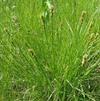
|
Carex bicknelliiSedge, Bicknell'S
Carex bicknellii can be found in North America from Eastern half of Canada and south to Kansas. It grows in dry and moist prairies, open woodlands and rocky areas. This Carex tolerates dry locations better than many sedges. It is useful for rain gardens, meadows, and areas where drought-tolerant plants are required. Bicknell’s Sedge grows in tufts of green, narrow, grasslike foliage and spreads by rhizomes. Copper-colored, oval-shaped seedheads appear in late spring giving it one of its common names. Carex bicknellii is named in honor of Eugene Pintard Bicknell (1859-1925), who is known for his keen observations of plant and animal life.
[
More Info
]
|
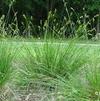
|
Carex breviorSedge, Shortbeak
A common sedge able to grow almost anywhere, most often found in the wild in dry, disturbed areas. Also called Plains Oval Sedge, Shortbeak Sedge actively grows during the spring and fall when soil temperatures are cool like most sedges (cool-season growers). In summer triangular leafy stems rise above low tufts of narrow grass-like foliage. The culms bear prickly green oval spikelets that transition into golden brown seed clusters.Leaf blades are usually about 1’ long and 1/8” wide. The leaf sheaths at the base of each blade has an unusual whitish color and an almost glassy appearance.
In late spring multiple leafy culms rise above the foliage to 3-4’. Each culm bears 2-6 oval flower spikes. Each green spikes contain upper pistillate and lower staminate florets. The spikelets are tapered at the base and bluntly pointed at the tip. The flowers transition into reddish brown summer seed spikes.
Plants are 1-4’ tall with an equal spread.
[
More Info
]
|
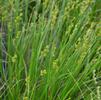
|
Carex buxbaumiiSedge, Brown Bog
[
More Info
]
|
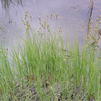
|
Carex crinitaSedge, Fringed
[
More Info
]
|
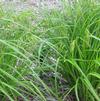
|
Carex eburneaSedge, Bristle-Leaved
Soft, thread-like, green foliage forms a spherical clump. Insignificant whitish-green flowers in April. Occurs naturally in limestone outcrops but also tolerates acid conditions.
[
More Info
]
|
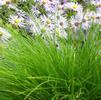
|
Carex flaccospermaSedge, Blue Wood
Evergreen sedge forms attractive clumps of narrow, blue-green leaves. Thrives in moist conditions but will tolerate drought. An American native groundcover for shade. Greenish-white flower is insignificant.
[
More Info
]
|
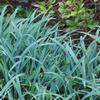
|
Carex frankiiSedge, Frank'S
Hardy grass-like plant with green foliage. Bristle-like, brown seed heads in May to September. Native to floodplain woodlands. AKA Bristly Cattail Sedge.
[
More Info
]
|
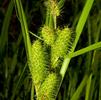
|
Carex grayiSedge, Bur
Attractive, evergreen pleated foliage is lime green in full sun and dark green in part shade. Spiked flowers in May form star-like seed heads. A Midwest native.
[
More Info
]
|
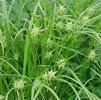
|
Carex hirsutellaSedge, Fuzzy Wuzzy
[
More Info
]
|
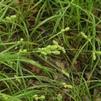
|
Carex muskingumensisSedge, Palm
A dense, clump-forming sedge which is grown for its foliage effect. Produces rigid, erect stems to 20" tall with 8" long, pointed, grass-like, light green leaves radiating from the stem tops. Commonly called palm sedge since the leaves somewhat superficially resemble miniature palm fronds. A Missouri native which is found most often in wooded swamps and on wooded flood plains of rivers. Spread by rhizomes and self-seeding. Insignificant flowers appear in May on terminal spikes which are not showy but are noticeable and of some interest and persist throughout the summer. Foliage promptly turns yellow after frost. Species is named for the Muskingum River in Ohio.
[
More Info
]
|
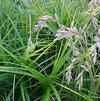
|
Carex pensylvanicaSedge, Pennsylvania
A compact sedge with arching, semi-evergreen, fine-texture foliage. An excellent shade to part shade groundcover. Tolerant of tough urban conditions, especially under trees. An American native.
[
More Info
]
|
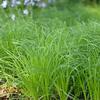
|
Carex radiataSedge, Straight-Styled Wood
Fine textured, grass-like, medium green foliage forms a tidy clump. A drought tolerant groundcover for shady sites. A Midwest native.
[
More Info
]
|
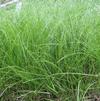
|
Carex shortianaSedge, Short'S
[
More Info
]
|
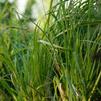
|
Carex strictaSedge, Tussock
A wetland native that grows in 2-3' tall clumps about 2' wide. As old leaves die, they build up around the living plant, making a "tussock" or little hill. It grows in or near water and spreads by rhizomes.
[
More Info
]
|
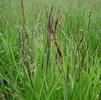
|
Carex vulpinoideaSedge, Fox
Missouri native sedge grows on moist open ground in swamps, wet prairies or near water, is one of the most abundant sedges in the state. Foliage consist of narrow grass-like leaf blades. The seed heads, which spray out attractively from the center of the clump, resemble a fox's tail but are short-lived.
[
More Info
]
|
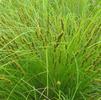
|
Cephalanthus occidentalisButtonbush
Blooms late June or July.
[
More Info
]
|

|
Chasmanthium (syn Uniola) latifoliumGrass, Northern River Oats
Upright clumps of bamboo-like foliage. Green foliage turns copper in fall and brown in winter. Attractive flat flower spikes hang down from flowering stems. Prefers light shade and damp locations. Can self-sow.
[
More Info
]
|
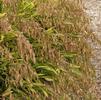
|
Chelone glabraTurtlehead
White spike flowers with a tinge of pink appear August through October. Flowers look like a turtle's head. Deep green foliage on upright stems looks good all season. A Midwest native.
[
More Info
]
|
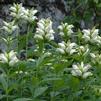
|
Conoclinium coelestinumMist Flower (Wild Ageratum)
Blooms September through October. (FKA Eupatorium coelestinum)
[
More Info
]
|
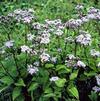
|
Coreopsis lanceolataCoreopsis, Lance-Leaf
Showy, single, gold-yellow flowers on tall stems in May and June.
[
More Info
]
|
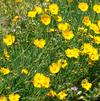
|
Coreopsis palmataCoreopsis, Prairie
Pale yellow flowers--much softer in color than those of our other native coreopsis--are carried on stiff, upright stems for several weeks, beginning in late spring. Spreads by rhizomes and seed, eventually forming large colonies.
[
More Info
]
|
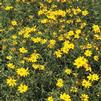
|
Coreopsis tripterisCoreopsis, Tall
[
More Info
]
|
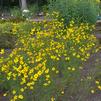
|
Dalea (syn Petalosteum) purpureaClover, Purple Prairie
A native Missouri prairie clover which occurs in glades, rocky open woods and prairies in much of the state. It features tiny purple flowers in dense, cone-like heads atop erect, wiry stems late June through September.
[
More Info
]
|
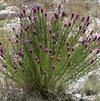
|
Deschampsia cespitosa 'Goldtau'Hairgrass, Tufted
This lovely cultivar of Deschampsia cespitosa shares many attributes with the species: clump growing, semi evergreen, fine textured leaves, and thin stems topped with sprays of airy delicate flowers. However, Deschampsia cespitosa ‘Goldtau’ has yellowish seeds heads that turn golden in the fall and provide wonderful winter interest. Deschampsia cespitosa performs best and flowers most in cooler climates. In warmer climates, Golden Dew Tufted Hair Grass needs semi-shade and moist conditions.
[
More Info
]
|
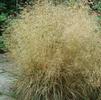
|
Diarrhena obovataBeakgrain, American
[
More Info
]
|
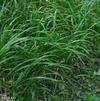
|
Dryopteris marginalisFern, Eastern Wood
Tough, adaptable evergreen fern with olive green arching fronds that grow in a vase shape. Established plants are reasonably drought tolerant. The leathery leaves of Dryopteris marginalis are a beautiful addition to the woodland garden and can form a lovely an easy to maintain groundcover. A sturdy east coast native, it forms a tidy clump that will not spread and is very tolerant of dry shade conditions once it has established. Marginal wood fern is often found in shaded crevices of rocky ledges and bluffs from Newfoundland to Georgia, west to Oklahoma and Minnesota.
[
More Info
]
|
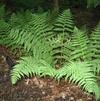
|
Echinacea pallidaConeflower, Pale
Tall bare stems are topped by flowers with narrow, strap-like pink-purple petals. Tolerates very dry soil.
[
More Info
]
|
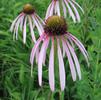
|
Echinacea paradoxaConeflower, Yellow
Each flower stem produces a single bloom with yellow ray petals around a brown cone-shaped seed head. A very drought tolerant Midwest native.
[
More Info
]
|
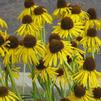
|
Echinacea purpureaConeflower, Purple
Rosy purple flowers with non-drooping petals. A Midwest native.
[
More Info
]
|
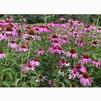
|
Echinacea purpurea 'RUBY STAR Rubinstern'Coneflower
Large carmine-red to purple flowers bloom June to August. Seed heads attract finches and other songbirds. Tolerant of drought, heat, humidity and poor soils. Said to be an improvement over `Magnus'.
[
More Info
]
|
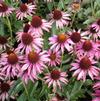
|
Elymus canadensisGrass, Canada Wild Rye
[
More Info
]
|
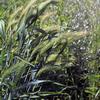
|
Elymus hystrixBottlebrush Grass
Missouri native perennial grass. Adaptable to wide variety of soils--tolerates clay soil. Medium green leaf blades grow to 1' long. Nine inch long "bottlebrush" inflorescences emerge in the summer, are held well above the foliage, and persist well into the fall.
[
More Info
]
|

|
Equisetum hyemaleRush, Horsetail
Bamboo-like, dark green stems are rigid, rough and hollow. Evergreen stems provide winter interest in water and bog gardens or in a low wet spot. Can be aggressive.
[
More Info
]
|
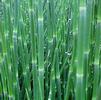
|
Eryngium yuccifoliumRattlesnake Master
Clusters of round, greenish white flower heads June through September on sword shaped, medium green foliage. Distinctive plant is an interesting cut flower. A drought-tolerant Midwest native.
[
More Info
]
|
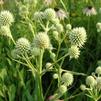
|
Eupatorium dubium 'Little Joe'Joe Pye Weed
A compact Joe Pye Weed that needs no staking. Flowers are produced in the usual dome-shaped clusters. Mauve-purple flowers on dark purple stems and green foliage July through September. Butterfly magnet. An outstanding, underutilized shrub-like perennial. More tolerant of light shade that other E. purpureum.
[
More Info
]
|
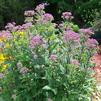
|
Eupatorium maculatumJoe-Pye Weed
Joe-Pye Weeds are bold, architectural specimen plants, perfect for making a statement in the border. Plants forms a huge clump of coarse green leaves, bearing enormous umbrella-like heads of rosy-purple flowers in late summer. Eupatorium maculatum is perfect for planting in damp soil in marshy areas, along streambanks, and on pond edges. Joe Pye Weed (also called Spotted Joe Pye Weed) also thrives in rich garden soil.
[
More Info
]
|
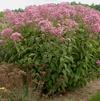
|
Eupatorium purpureumJoe Pye Weed
[
More Info
]
|
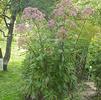
|
Fragaria virginicaStrawberry, Wild
Virginia strawberry or wild strawberry is a ground-hugging plant rising from a fibrous, perennial root system. Hairy leaf petioles, up to 6 in. long, each bear a single trifoliate leaf. The hairy flower stalk gives rise to a loose cluster of small, five-petaled flowers followed by tasty, wild strawberries.
Found in patches in fields and dry openings, this plant produces the finest, sweetest, wild strawberry.
[
More Info
]
|
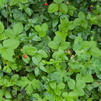
|
Helianthus occidentalisSunflower, Western
[
More Info
]
|
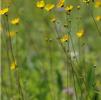
|
Heliopsis helianthoidesSunflower, Ox-Eye
Golden yellow daisy-like flowers bloom for weeks in summer and make good cut flowers. Seed heads are attractive to songbirds. Pinch for shorter, bushier plants.
[
More Info
]
|
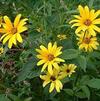
|
Heliopsis helianthoides 'Sunstruck'Sunflower, False
ariegated Heliopsis have long been popular in the perennial landscape, and ‘Sunstruck’ fills the spaces at a much shorter height. 2” large, golden yellow flowers appear above the cream and green variegated foliage even earlier than typical Heliopsis, and blooms all through summer until fall. Compared to ‘Loraine Sunshine’, ‘Sunstruck’ is more compact, has more ray florets and a deeper flower color.
[
More Info
]
|
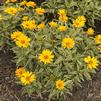
|
Heuchera americana 'Dale's Strain'Coral Bells
Unique silver-blue marbled foliage accented by white flowers on long panicles in May and June. Excellent drought tolerant ground cover. Foliage display is amazing!
[
More Info
]
|
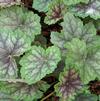
|
Heuchera richardsoniiAlum Root
Clump forming green foliage forms rounded mound. New foliage has some white mottling or purple blush. Tiny, greenish flowers on slender stems 18-24" above foliage in May and June. Very winter hardy.
[
More Info
]
|
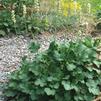
|
Hibiscus 'Vintage Wine'Hibiscus, Hardy
Near-black buds open to huge 7", scarlet red flowers that shimmer in the sun with a darker red eye. The overlapping petals of ‘Vintage Wine’ have a crinkled texture and open completely with minimal cupping. Flowers are produced from the top to the bottom of the plant, rather than only at the top like some older cultivars.
Dark green, heart-shaped leaves form a densely upright, columnar clump. Use this incredibly dense variety as a focal point in your sun garden.
‘Vintage Wine’ differs from ‘Cranberry Crush’ with the shape of its leaves, the tone of flower color (a warmer red), and the density of its plant habit.
[
More Info
]
|
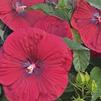
|
Hibiscus lasiocarpusHibiscus, Rose Mallow
White or pink flowers with red centers grow 4 to 5 in. across. Flowers open for many weeks in July through October.. Large fuzzy leaves and a shrublike form give this plant substantial bulk in the landscape. Plants generally break dormancy late in spring so be patient. Tolerates some shade but flower production is best in full sun. Tolerates heat and humidity.
[
More Info
]
|
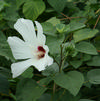
|
Hydrangea arborescensHydrangea
[
More Info
]
|

|
Iris cristataIris, Dwarf Crested
Clouds of pretty blue flowers float just above the foliage for two weeks in April or May. Unlike many iris, the foliage is handsome all through summer. Nice edging plant for the front of a shaded garden or path. Also a good slow moving ground cover.
[
More Info
]
|
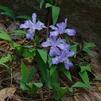
|
Iris fulvaIris, Copper
Unusual copper color flower is a beardless variety native to swamps and wetlands. Flowers appear in May and June on tall scapes. Bright green foliage is sword shaped. Pollinated by hummingbirds.
[
More Info
]
|
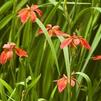
|
Iris virginica var. shreveiIris, Southern Blue Flag
This moisture-loving iris has fragrant, blue violet flowers with falls crested in yellow and white. Narrow, bright green leaves often lie on the ground or in water.
[
More Info
]
|
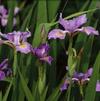
|
Juncus effususRush, Soft
A native clump-forming wetland plant with dark green soft, round stems. An effective foliage accent for pools, ponds and stream sides. Will grow in shallow water or bogs. Foliage turns yellow in fall before turning brown. Insignificant golden flowers June through August. Attracts songbirds.
[
More Info
]
|
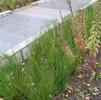
|
Juncus tenuisRush, Poverty
[
More Info
]
|
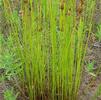
|
Koeleria macranthaGrass, June
[
More Info
]
|
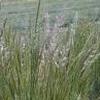
|
Liatris spicataBlazing Star
Deep purple flower spikes in July and August on erect, grass-like stems. Tolerant of drought, heat and humidity. Attracts songbirds.
[
More Info
]
|
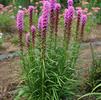
|
Lobelia cardinalisCardinal Flower
[
More Info
]
|
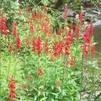
|
Lobelia siphiliticaLobelia, Blue
Stout spikes of two-lipped blue flowers bloom in September and October. Excellent for attracting butterflies and hummingbirds. Great lobelia is a Missouri native perennial which typically grows in moist to wet locations along streams, sloughs, springs, swamps, meadows and in low wooded areas. May self-seed in optimum growing conditions, forming attractive colonies.
[
More Info
]
|
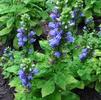
|
Matteuccia struthiopterisFern, Ostrich
One of the largest and most popular perennial ferns. Dark green fronds are shaped like ostrich plumes. Clump forming, upright to arching habit. Rapid spreader requiring space to grow. Good ground cover that spreads rapidly in moist areas.
[
More Info
]
|
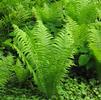
|
Mimulus ringensMonkey Flower, Allegehny
Lilac-purple snapdragon-like flowers appear in pairs June through September. Upright foliage is bright green. Native to swampy areas, wet meadows and low woods. Spreads by creeping rhizomes.
[
More Info
]
|
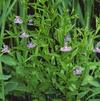
|
Monarda bradburyanaBergamot, Wild
[
More Info
]
|
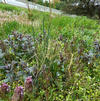
|
Monarda fistulosaBergamot, Wild
Spidery pompons of lavender blossoms are irresistible to butterflies and hummingbirds, and the fragrant gray-green foliage is wonderful in a scent garden or herb garden. Provide good air circulation to minimize powdery mildew, and deadhead to prolong flowering.
[
More Info
]
|
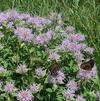
|
Monarda x didyma 'Blue Moon'Bee Balm
Lavender blue flowers are held by attractive purple bracts.A breakthrough, shorter height for this color.The members of the SUGAR BUZZ® Series from the Walters Gardens, Inc. hybridizing program are perfectly suited to the middle of the flower border at 16-24" tall. All members in this series are similar in size, bloom time, and vigor, making it easy for growers to offer the entire series. In midsummer, they form a solid dome of color with their 2-2.5" flowers on strong, well-branched stems. The dark green foliage forms an upright clump with enough vigor to quickly fill out containers nicely but are not aggressive in the garden. As with all Monardas from the Walters Gardens, Inc. hybridizing program, these display above average resistance to powdery mildew.
[
More Info
]
|
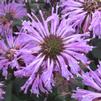
|
Monarda x didyma 'Jacob Cline'Bee Balm
Large bright red flower clusters appear July through September. Upright, mildew resistant, fragrant foliage can be used to flavor tea. Attracts hummingbirds.
[
More Info
]
|
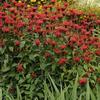
|
Oenothera macrocarpa (syn missouriensis)Sundrops, Ozark
Large yellow flowers, up to 4" across, are mildly fragrant. Plants trail and look good in a rock garden. Plants tolerate poor soil and drought but need good drainage. (syn. O. missouriensis)
[
More Info
]
|
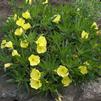
|
Onoclea sensibilisFern, Sensitive
Large somewhat course textured foliage is bright green. Fertile fronds turn dark brown and roll up. Native to wet woods and moist soils along streams. Sensitive to frost and drought. Fast-creeping rhizomes produce a carpet of light green fronds. A tough fern that thrives in moist soil. Plants die down at the first hint of frost but ornamental fertile fronds remain. These can be used in dried arrangements.
[
More Info
]
|
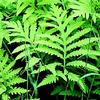
|
Osmunda cinnamomeaFern, Cinnamon
[
More Info
]
|
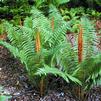
|
Osmunda regalisFern, Royal
Mature fronds are lance-shaped and light green and grow in a vase shape. The fronds resemble leaves from plants in the legume family such as a locust tree. Spreads slowly.
[
More Info
]
|
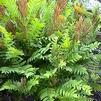
|
Panicum virgatum 'Heavy Metal'Grass, Switch
[
More Info
]
|
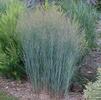
|
Panicum virgatum 'Northwind'Grass, Switch
[
More Info
]
|
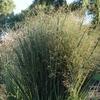
|
Panicum virgatum 'Prairie Fire'Grass, Switch
[
More Info
]
|

|
Panicum virgatum 'Ruby Ribbons'Grass, Switch
[
More Info
]
|

|
Panicum virgatum 'Shenandoah'Grass, Switch
[
More Info
]
|
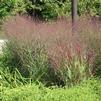
|
Parthenium integrifoliumQuinine, Wild
Clump-forming, Missouri native perennial which occurs in dry soils on prairies, glades and rocky woods. Grows 3-4' tall. Woolly-looking, white flower headsMay to august. Leaves are aromatic, toothed and rough. Former medicinal use as a diuretic. Also called American Feverfew.
[
More Info
]
|
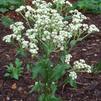
|
Parthenocissus quinquefoliaVirginia Creeper
[
More Info
]
|

|
Penstemon digitalisPenstemon, Foxglove
Clump-forming, Missouri-native perennial typically occurs in prairies, fields, wood margins, open woods and along railroad tracks. Abundant plumes of tubular white flowers provide nectar for hummingbirds April through June. Attractive seed heads and reddish fall color extend seasonal interest. Attracts songbirds.
[
More Info
]
|
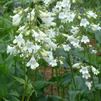
|
Penstemon digitalis 'Blackbeard'Beardtongue
Dark purple flower stems hold its lilac purple flowers with their white flaring tubes high above the low mound of deep eggplant purple leaves. Attractive dark burgundy seed pods follow the flowering performance for extended seasonal interest. ‘Blackbeard’ stays strictly upright all season long.
It takes the heat and humidity in stride but is also very cold hardy. It continues to provide terrific color in the landscape all season long.
[
More Info
]
|

|
Penstemon digitalis 'Husker Red'Penstemon, Foxglove
Foliage emerges purple-bronze and matures to green. Profusion of white flowers on wiry stems. Grows best in full sun and moist soil. [PPA-1996]
[
More Info
]
|
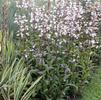
|
Phlox divaricata 'Blue Moon'Phlox, Woodland
Violet-blue, fragrant flowers bloom in April and May. Puts on quite a show when in blooms. A long lived, carefree native groundcover.
[
More Info
]
|
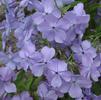
|
Phlox divaricata var. laphammiPhlox, Woodland
[
More Info
]
|
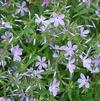
|
Phlox paniculataPhlox, Meadow
[
More Info
]
|
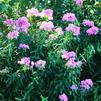
|
Physocarpus opulifoliusNinebark
[
More Info
]
|

|
Physostegia virginiana 'Miss Manners'Obedient Plant
[
More Info
]
|
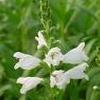
|
Polemonium reptansJacob'S Ladder
[
More Info
]
|
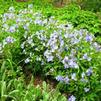
|
Polystichum acrostichoidesFern, Christmas
Glossy, dark green foliage is evergreen. Fronds emerge upright, arching as they mature to cover ground. Drought tolerant once established. Tiny leaves resemble Christmas stockings.
[
More Info
]
|
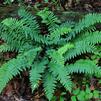
|
Pontedaria cordataPickeral Weed
[
More Info
]
|
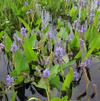
|
Pycnanthemum tenuifoliumMint, Slender Mountain
[
More Info
]
|
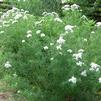
|
Ratibida pinnataConeflower, Grey Headed
Large yellow flowers with drooping petals surround a brown seed head. Plants bloom profusely all summer. Birds eat the seed if old flowers are left on the plant.
[
More Info
]
|
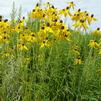
|
Rudbeckia fulgidaConeflower, Orange
Masses of golden daisies from mid to late summer on long-lived, adaptable plants. Equally useful in a flower border or prairie meadow.
[
More Info
]
|
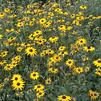
|
Rudbeckia missouriensisBlack-Eyed Susan, Missouri
This native is loaded with gold flowers with brown centers for several weeks in summer.
[
More Info
]
|
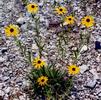
|
Rudbeckia subtomentosaConeflower, Sweet
Lovely, butter yellow daisies, each 3 across, decorate large, well-branched plants. Foliage is an attractive gray-green. For more compact plants, pinch lightly in spring.
[
More Info
]
|
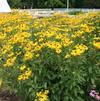
|
Ruellia humilisPetunia, Hairy Wild
Wild petunia is a Missouri native perennial which occurs in dryish soils in open woods, glades, prairies and fields throughout the State except for the far southeastern lowlands. Charming, low growing clumps produce light purple tubular flowers from May to Oct. The flowers arise in groups at the leaf axis. The square stems and the leaves are both quite hairy-a natural defense against dry conditions.
[
More Info
]
|
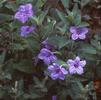
|
Salvia azureaSage, Blue
[
More Info
]
|

|
Schizachyrium (syn Andropogon) scopariumGrass, Little Bluestem
Green to blue-green leaves turn deep red in the fall. One of our native prairie grasses that is perfectly suited to hot humid summers.
[
More Info
]
|
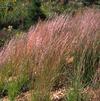
|
Schizachyrium (syn Andropogon) scoparium 'Blaze'Grass, Little Bluestem
Valued ornamentally for its vivid red fall foliage. In winter it remains a standout as the leaves fade to deep pink. Easily grown and adapts to any soil type, including clay. Heat and drought tolerant.
[
More Info
]
|
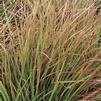
|
Schizachyrium (syn Andropogon) scoparium 'Blue Heaven'Grass, Little Bluestem
Tall, upright form with beautiful blue-grey foliage that turns to burgundy red with purple and violet highlights in fall. The fall color lasts well into November. Small, fluffy white flowers form in late summer.
[
More Info
]
|
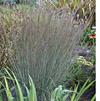
|
Schizachyrium (syn Andropogon) scoparium 'Carousel'Grass, Little Bluestem
An improved selection of the native bluestem, with stems that remain sturdy through the winter. Compact blue-green foliage turns shades of copper, beiges and oranges in the autumn.
[
More Info
]
|
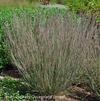
|
Schizachyrium (syn Andropogon) scoparium 'Prairie Blues'Grass, Little Bluestem
An improved selection of the native bluestem. It offers striking gray-blue, upright foliage that takes on reddish-orange tones in the fall. Fluffy silver seed heads from late summer well into fall.
[
More Info
]
|
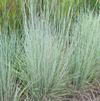
|
Sedum ternatumStonecrop, Woodland
Blooms late April through May.
[
More Info
]
|
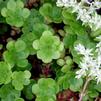
|
Senecio (syn Packera) obovatusSquaw-Weed
[
More Info
]
|
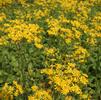
|
Silphium laciniatumCompass Plant
[
More Info
]
|
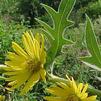
|
Sisyrinchium angustifolium 'Lucerne'Grass, Blue-Eyed
Bright blue star shaped flowers with gold centers rise above fine, Iris-like foliage from late April or early May until July. Excellent for edging.
[
More Info
]
|

|
Solidago drummondiiGoldenrod, Cliff
Graceful, arching stems are crowded with tiny, bright yellow, daisy like flowers in late summer to fall. Flowers attract butterflies and other pollinators. Basal leaves generally dry up and disappear by flowering time but leaves toward the top of stems remain. Plant Cliff Goldenrod where it can hang over a rock wall for a be
[
More Info
]
|
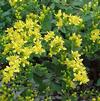
|
Solidago flexicaulisGoldenrod, Zigazg
[
More Info
]
|
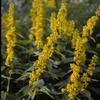
|
Solidago rugosa 'Fireworks'Goldenrod
Impressive, lacy sprays of golden yellow flowers in September and October. Flower clusters radiate out in all directions and resemble fireworks on arching bushy foliage. Basal foliage is evergreen. Extremely drought tolerant, as exhibited at Alwerdt's Gardens in Altamont, Il during the summer 2002 drought.
[
More Info
]
|
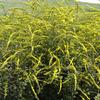
|
Solidago speciosaGoldenrod, Showy
Dense, erect clusters of bright yellow flowers top tall reddish stems in late summer and early fall. "Speciosa" is Latin for "showy," and this goldenrod certainly fits that bill. Clump forming.
[
More Info
]
|

|
Sorghastrum nutansGrass, Indian
Upright clumps of slender, blue-green leaves turn golden yellow in fall. Stiff, vertical flowering stems, topped with 12" long, narrow, light brown flower panicles with yellow stamens, rise well above the foliage in late summer.
[
More Info
]
|
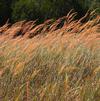
|
Spartina pectinataGrass, Prairie Cordgrass
[
More Info
]
|
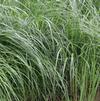
|
Spigelia marilandicaIndian Pink
Indian pink is a clump-forming, Missouri native perennial which occurs in moist woods and streambanks in the far southeastern part of the State. Features one-sided cymes of upward facing, trumpet-shaped, red flowers (to 2" long) atop stiff stems growing to 18" tall. Each flower is yellow inside and flares at the top to form five pointed lobes (a yellow star). Flowers bloom in June. Glossy green, ovate to lance-shaped leaves (to 4" long).
[
More Info
]
|
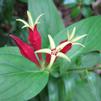
|
Sporobolus heterolepisGrass, Prairie Dropseed
Fine textured tufts of green foliage turn gold or deep orange in autumn. Pink flowers appear in August with fragrant seeds. Heat and drought tolerant. Attracts songbirds and wildlife.
[
More Info
]
|
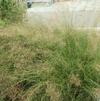
|
Sporobolus wrightiiGrass, Giant Sacaton
Gray-green foliage sports airy clouds of flowers atop tall stems in summer. This grass is good as a single specimen or in a group as a showy backdrop. Fast growing. Drought, heat and salt tolerant. Supstitute for Pampas Grass.
[
More Info
]
|
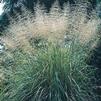
|
Stylophorum diphyllumPoppy, Celandine
Blooms April through June and frequently into July.
[
More Info
]
|
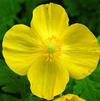
|
Tradescantia ohiensisSpiderwort, Ohio
Showy clusters of blue or rose flowers bloom on erect stems late May to early July. Each flower opens for one day. Cut back to 6-12" in mid summer to encourage new growth and possible fall bloom.
[
More Info
]
|
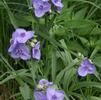
|
Verbena hastataVervain, American Blue
Numerous purplish-blue flowers on pencil-like spikes bloom July through September. Stiff and upright habit. Flowers bloom from bottom to top, a few at a time. A Midwest native enjoying wet soils.
[
More Info
]
|
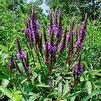
|
Verbena (syn Glandularia) canadensisVerbena, Rose
Lilac rose flowers are very attractive to butterflies. Plants bloom April through September. Low growing foliage makes a good ground cover. Not reliably hardy when associated with heavy, wet soil conditions during the winter months; best treated as an annual.
[
More Info
]
|
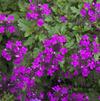
|
Vernonia arkansanaIronweed, Curlytop
Blooms August through September.
[
More Info
]
|

|
Vernonia fasciculataIronweed, Dwarf
Small purple flowers from August through September. This is a very durable, naturally short growing specie.
[
More Info
]
|

|
Vernonia lettermanniiIron Butterfly
Blooms August through September.
[
More Info
]
|
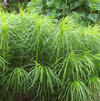
|
Vernonia noveboracensisIronweed
Blooms August through September.
[
More Info
]
|
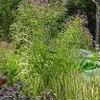
|
Veronicastrum virginicumCulver'S Root
Blooms June through August.
[
More Info
]
|
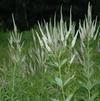
|
Zizia apteraGolden Alexanders
The thick, glossy semi-evergreen foliage looks a little like Lenten Rose and provides nice contrast to other native plants. Small yellow flowers in flat heads bloom May-June.
[
More Info
]
|
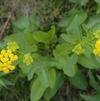
|
